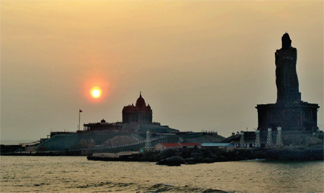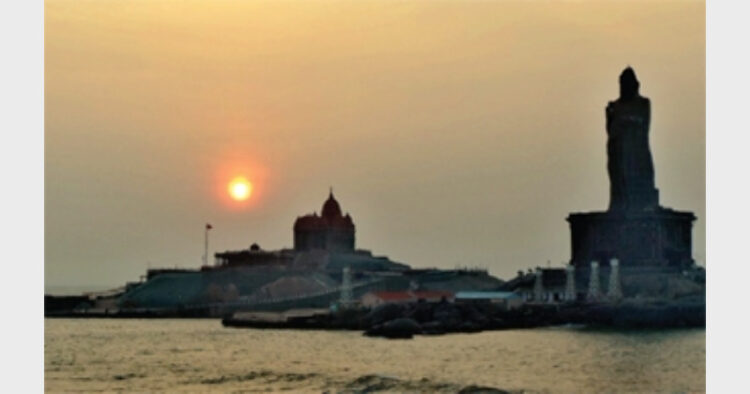
Intro: For ages, Bharat has been an assimilation of diverse culture which we recognise as our cultural heritage, but there are some footprints of Bharatiya tradition which have been neglected in the era of Globalisation and Tourism trade.
The most unique feature of Bharatiya Civilisation is ‘Unity in Diversity’. Bharat is a fusion of diverse culture, languages and people belonging to different communities. Our unity in diversity is so cohesive that we faced the foreign invasions together as one big family. Unity in diversity is one of the pillars of national integration. The Bharatiya Culture has been an assimilation of the traditions, dreams, art, music and ethnicity of variety of empires since ancient time.
Sri Walkeshwar Temple? Anyone who is travelling to the City of Dreams—Mumbai must visit Sri Walkeshwar Temple. The Temple is dedicated to Bhagwan Shiva; it is believed that the Shiv Lingam situated inside the temple was made by Bhagwan Ram during his campaign to Lanka. In local folklore it is also known as the Baan Ganga built in 1127 AD. The temple is situated at the top of Malabar hills in south Mumbai.? Swami Vivekananda’s Ancestral House ? Ramakrishna Mission Swami Vivekananda’s Ancestral House and Cultural Centre, a place where you can see the personal belongings of Swami Vivekananda. West Bengal is known for its thinkers, revolutionaries, culture, and sages. One such thinker, teacher and sage was Vivekananda. Young Narendra spent his childhood in this house, So if you’re visiting the City of Joy, Vivekananda’s Ancestral House is a must visit place. The house being managed by Ramkrishna Mission since 2004, the place where Vivekananda was born 151 years ago. ? Maluti Temples Maluti is famous for its 108 ancient temples dedicated to Goddess Mowlakshi, Durga, Kali, Gods Shiva and Vishnu, located on the border of Jharkhand and West Bengal. These ancient temples were created during the reign of Pala Dynasty. The temples made of Terracotta have great religious significance. Today, you will find only 72 temples remain intact.? Hampi Temples ? Hampi is one of the best tourist attractions if you’re visiting the southern part of the country. Hampi is recognised as a World Heritage Site by UNESCO. Hampi was once the greatest Hindu Dharmik Center in Vijayanagara Kingdom. It was flourished under the reign of various Vijayanagara Kings, who propagated and practiced religious tolerance and treated all religions equally. ? Kakatiya Temples ? Kakatiya Temples are dedicated to Bhagwan Shiva and are located in Nagunur Village of Andhra Pradesh. The Temples were built by Kakatiya Dynasty in 1200-1300 AD. Ramateertham Maitreya Temple Majuli Islands ? Majuli Islands is one of the biggest river islands of the world. Apart from its idyllic view it is also known as Capital of Vashnavism in Assam. In 15th century Srimanta Sankardeva established sixty five ‘satras’ in this area to Ram Kund Bhaja Caves Parasurameswar Temple Sri Surya Pahar The Ancient Town of Badami Badami formerly known as Vatapi, is a town and headquarters of Badami, in the Bagalkot district of Karnataka. According to the puranic story Agastya-Vatapi sage. Agastya killed the asura named Vatapi in this place so named Vatapi. Important tourist attractions in Badami are, Badami Fort, Shivalayas including the Malegatti Shivalaya with 7th century origins, Dattatreya Temple, Mallikarjuna Temple which dates back in 11th century and Temple of Banashankari. ?? Ram Setu Martand Sun Temple Kalady |
Bharat even today has deep imprints of Indus Valley Civilisa-tion, the Buddhist traditions, the Jains traditions, etc. Very few of us love history, but there is one thing certain about history that more we try to learn it, it makes us feel even more unlearned. Across the globe and throughout the ages, people have made pilgrimages; they have travelled India from length to breadth, seen all seasons and heard all languages. Most people do say that we are a diverse nation. Yes, we are, if you keep language, attire, food as the parameter to segregate but if we try to filter people by factors like belief, emotions, faith we are one breed with diverse colours. Our culture is one thing that has always united us, even from the times when we did not have a political identity.
Another Story: Vajpayee Government National Tourism Policy 2002?
Our culture is a combined package of various sub-sets such as literature, temples, dance, music, art and faith blended best way possible. I believe the best way to get connected to our culture is to meet our culture. It could be the holy water of Ganges or the magnificent vibes in Rameshwaram binds us with a common fiber. Cultural tourism has its roots deep rooted in Indian history; ranging from Shankaracharya Hill in the North to the Ram Sethu in the South and Somnath in the west to the Kamakhya in the east.
Another Story Cultural Tourism : The Treasure we Lost?
Diversity can be seen in Indian climatic conditions too. Here is the list of best places in India if you’re looking for winter holiday destinations. ? -Hitesh Rangra













Comments